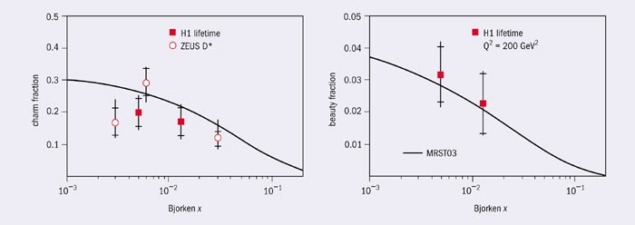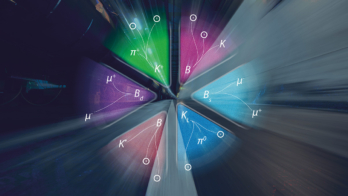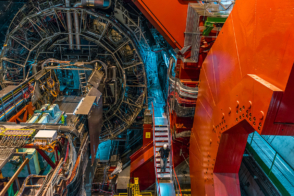The latest in the DIS series of workshops looked at probing the proton to reveal more about quantum chromodynamics.

DIS 2004 – the XII International Workshop on Deep Inelastic Scattering – took place in Strbské Pleso in the High Tatras mountains in Slovakia on 14-18 April. The DIS series of workshops provides a forum for bringing together the latest experimental and theoretical results, both to increase the understanding of quantum chromodynamics (QCD) and to unravel the complicated structure of the proton. Organized by the Institute of Experimental Physics at the Slovak Academy of Sciences in Kosice, in association with other Slovak high-energy physics institutes, DIS 2004 attracted 260 participants. After the welcome address by Slovak president Rudolf Schuster, the programme followed its usual well-tried format. It began with almost a full day of plenary review talks, before the participants divided up into working groups on the following topics: structure functions and low x; diffraction and vector mesons; hadronic final states; heavy flavours; electroweak and physics beyond the Standard Model; and spin physics. After three days the plenary session reconvened for reports from the working groups.
One of the hot topics was pentaquarks. Here, the experimental situation is puzzling. The narrow Θs(1530) state with B=S=1, predicted by the chiral soliton model, is seen by several experiments, including ZEUS and HERMES at HERA, but it has not yet been observed by HERA B. On the other hand H1 reports a narrow B=-C=±1 state at 3099 MeV, perhaps a little heavy for a Θc pentaquark, which is not seen by ZEUS.
Another exciting area is spin physics, which is about to enter a new era. High-precision data are due soon from the COMPASS experiment at CERN, from the Thomas Jefferson National Accelerator Facility (Jefferson Lab) and from the Relativistic Heavy Ion Collider at Brookhaven. These data will supplement the extensive information coming from HERMES and thereby probe the intricate spin structure of the proton. Jefferson Lab already has the first precise measurements of the structure function for scattering from transversely polarized neutrons, g2n, which allow a study of twist-3 operators.
Heavy quarks and gluons
The presentations of more accurate data on heavy flavours, together with a better implementation of QCD, showed that the discrepancy between the data and predictions on b-bbar production, found both at Fermilab’s Tevatron and at HERA, has largely been resolved. Moreover, measurements were presented of the structure function F2b for the first time. This directly probes the b-quark content of the proton, while contributing only about 2% of the total proton structure function F2 in the accessed region of high momentum transfer, Q2, and Bjorken x of 0.01 (see figure 1).

Indeed, there was considerable discussion on the partonic structure of the proton, which, in addition to its intrinsic interest, is so important for improving the predictions for searches at the Large Hadron Collider (LHC) at CERN. The experiments at HERA have opened up the domain of small x, and the present precision of the data allowed searching questions to be discussed at the workshop. What are the properties of the gluon? How large is the kinematic domain in which the Dokshitzer-Gribov-Lipatov-Altarelli-Parisi (DGLAP) evolution of parton densities is valid? Are ln(1/x) effects evident in the data? Is there any evidence of absorptive effects coming from parton recombination, or even of parton saturation? The experiments at HERA observe diffractive DIS events at about 10% of the rate of inclusive DIS events: what role does this diffractive process play? What is important for HERA to measure now?
One of the discoveries of HERA is the unexpected behaviour of the gluon. Analyses of the data at small x surprisingly reveal a valence-like gluon at low scales, whereas it is the sea quarks that grow with decreasing x. Moreover, the gluon is not well determined. For example at Q2 = 100 GeV2 there is at least a 10% uncertainty arising just from the statistical and systematic errors on the data, which becomes much greater at small and large x. Discussions at the workshop concentrated on the equally, and perhaps more, important theoretical uncertainties on the determinations of the partons.
One major source of uncertainty was considerably reduced when Sven-Olaf Moch, Jos Vermaseren and Andreas Vogt presented, for the first time, the complete next-to-next-to-leading-order (NNLO) splitting functions. Their exact results lie in the middle of the approximate bounds previously determined, so the existing NNLO global analyses based on these bounds will be approximately valid. As of this workshop DIS studies have entered the NNLO era. Of course this is for evolution of the parton density within a pure DGLAP framework, which must break down at sufficiently low x and low Q2. Presentations at the workshop showed that additional ln(1/x) effects are being brought under control; the indications are that they are not large in the kinematic domain explored at HERA.
There was also much discussion of parton saturation. The alternative non-linear equations, which describe saturation, are in fact equivalent; they simply view the parton recombination process from different Lozentz frames. Despite the theoretical activity the consensus of the workshop was that there was no evidence of saturation in the perturbative domain of the HERA data. This does not mean that absorption corrections – signalling the onset of saturation – are negligible. Indeed the recent diffractive DIS data from HERA allow an estimate of such effects, and hence of their influence on global parton analyses.
Looking at more detailed assumptions used in parton analyses, it became clear that the NuTeV experiment’s anomaly in sin2θW may not exist. If we allow for strange quarks with s≠ sbar, for isospin violating effects, and for contributions from quantum electrodynamics, then each is found to reduce the anomaly significantly. Indeed there are several aspects of the partonic structure that are within reach, if much more accurate measurements are made, including the valence d-quark distribution from charged-current positron-proton scattering; s – sbar from dimuon production in neutrino scattering; and the valence u+d distributions at low x ≈ 0.1 from high statistics electron and positron data from HERA.
The identification of new physics at the LHC, Tevatron or HERA is likely to require precise predictions from the Standard Model, which in turn rely on accurately known partons. However, the gluon distribution, which is at the heart of parton analyses, is poorly known. It is determined by the scaling violations of F2, by F2-charm and by jet data from the Tevatron and HERA. It became clear at DIS 2004 that it is crucial to measure the longitudinal structure function FL; it is a direct “orthogonal” measure of the gluon. Simulations that were presented showed how running HERA at four different proton energies would have a decisive effect on determining the gluon, and, in turn, much improve the determination of the QCD coupling.
Precision diffractive DIS data are now available, and diffractive parton densities were presented. These densities are not universal. Care is required to take them from one diffractive process to another, since we must allow for the probability that the rapidity gaps survive population by secondaries from the underlying event. The probabilities depend on the diffractive process. There was much discussion of the new data for these exclusive diffractive processes, both from HERA and the Tevatron. The analysis of the recent HERA data for the photoproduction of dijets was particularly illuminating in this respect.
A prosperous future?
In summary, DIS continues to flourish, with the presentation of a wealth of new results that produced vigorous debate. Much remains to be learnt and we are only just getting to grips with many basic problems, for which the data are either insufficient or even absent. It is inconceivable that HERA will not measure FL – but it remains to be done. There are a host of processes for which a ten-fold increase in luminosity would be invaluable, even forgetting the possibility of the discovery of surprise exotic phenomena. It became clear at the workshop that probing the proton at high energies is revealing more and more information about QCD, which needs to be theoretically understood, with important implications for all high-energy phenomena and the LHC in particular. It would be a tragedy if the HERA programme ran out of time while the physics potential of the machine is just coming to its prime.





